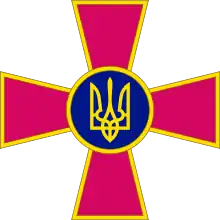Ukrainian Air Force
The Ukrainian Air Force (Ukrainian: Повітряні Сили України, Povitryani Syly Ukrayiny) is a part of the Armed Forces of Ukraine.[5] The Ukrainian Air Force headquarters is located in the city of Vinnytsia. When the Soviet Union dissolved in 1991, many aircraft were left on Ukrainian territory. Ever since, the Ukrainian air force has been downsizing and upgrading its forces. The main inventory of the air force still consists of Soviet-made aircraft. Currently 36,300 personnel and 144 aircraft are in service in the Ukrainian air force and air defense forces[6][7] but approximately only eighty aircraft are airworthy.[8] All ICBMs and strategic bombers have been taken out of service (some however were given to Russia).[9]
| Ukrainian Air Force | |
|---|---|
| Повітряні Сили України Povitryani Syly Ukrayiny | |
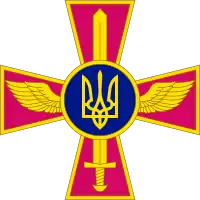 Emblem of the Ukrainian Air Force | |
| Active | 1917–1921, 1992–present |
| Country | |
| Type | Air force |
| Role | Aerial warfare |
| Size | 45,000 personnel Approx 125 aircraft [1] |
| Part of | Armed Forces of Ukraine |
| Headquarters | Vinnytsia |
| Anniversaries | 6 August: Air Force Day [2] |
| Engagements | |
| Commanders | |
| Commander | Serhiy Drozdov [4] |
| Insignia | |
| Roundel |  |
| Fin flash | 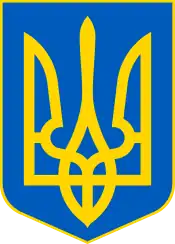 |
| Flag | 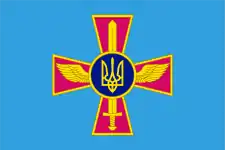 |
| Aircraft flown | |
| Attack | Su-24, Su-25 |
| Fighter | MiG-29, Su-27 |
| Helicopter | Mil Mi-8 |
| Attack helicopter | Mil Mi-24 |
| Reconnaissance | An-30, Su-24MR, Bayraktar TB2 |
| Trainer | Aero L-39 |
| Transport | Il-76, An-24, An-26, An-30, An-70 |
Since 1991's Ukrainian independence the air force has suffered from chronic underinvestment, leading to the bulk of its inventory becoming mothballed or otherwise becoming inoperable.[10] Despite this Ukraine still possesses the world's 27th largest air force and the 7th largest air force in Europe, largely due to the ability of its domestic defense industry Ukroboronprom and its Antonov subsidiary to maintain its older aircraft.[11]
The air force participated in the War in Donbass,[3] but following the 5 September 2014 ceasefire, the Ukraine Air Force has been forbidden from carrying out missions in the contested areas of Donbass.[12]
Missions
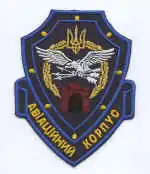
The tasks of the Air Force of Ukraine are: winning operational air superiority, delivering air strikes against enemy units and facilities, covering troops against enemy air strikes, providing air support to the Land Force and the Navy, disrupting enemy military and state management, damaging and destroying enemy communication, and providing support by air in the form of reconnaissance, air drops, troops and cargo transportation.
The major mission of the Air Force is to protect the air space of Ukraine. In peace-time, this is carried out by flying air-space control missions over the entire territory of Ukraine (603,700 square km), and by preventing air space intrusion along the aerial borders (totaling almost 7,000 km, including 5,600 km of land and 1,400 km of sea). Every single day, more than 2,200 service personnel and civilian employees of the Air Force, employing 400 items of weapons and equipment, are summoned to perform defense duties. On average, the Ukrainian radar forces detect and track more than 1,000 targets daily. As a result, in 2006 two illegal crossings of the state border were prevented and 28 violations of Ukrainian air space were prevented. Due to such increased strengthening of air space control, the number of air space violations decreased by 35% compared to the previous year, even though the amount of air traffic increased by 30%.[13]
History
1917–1921
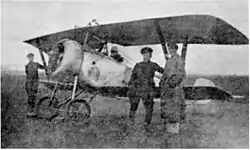
The roots of Ukrainian military aviation are in the autumn 1917 creation of the Ukrainian People's Republic Air Fleet, headed by former commander of the Kyiv Military District Lieutenant Colonel Viktor Pavlenko. Previously, while in Russian service in World War I, Pavlenko was in charge of air security of the Russian Stavka.
Sometimes in 1918 the West Ukrainian People's Republic created its own aviation corps with the Ukrainian Galician Army headed by Petro Franko, a son of renown Ukrainian writer Ivan Franko. In 1918 he organized an aviation school of the Ukrainian Galician Army Command Center which was active until 1920.
Among the airplanes used by the Ukrainian aviation in this period were Belgium-built SPAD S.VIIs. The Ukrainian Galician Army used Nieuport 17 biplanes.
Collapse of the USSR
The Ukrainian Air Force was established on March 17, 1992, in accordance with a Directive of the General Staff Chief of the Armed Forces. The headquarters of the 24th Air Army of the Soviet Air Force in Vinnytsia served as the basis to create the Air Force headquarters. Also present on Ukrainian soil were units of the former Soviet 5th, 14th, and 17th Air Armies, plus five regiments (185th, 251st, 260th, 341st Heavy Bomber Aviation Regiments and 199th Reconnaissance Aviation Regiment) of the 46th Air Army, Long Range Aviation. In addition, the 161st Maritime Fighter Aviation Regiment, at Limanskoye in Odessa Oblast, came under Ukrainian control.[14] It had formerly been part of the 119th Maritime Fighter Aviation Division of the Black Sea Fleet.
The new Air Force inherited the 184th Guards Heavy Bomber Aviation Regiment (201st Heavy Bomber Aviation Division) of Tupolev Tu-160 'Blackjack' which were based at Pryluky.[15] Discussions with Russia concerning their return bogged down. The main bone of contention was the price. While Russian experts, who examined the aircraft at Pryluky in 1993 and 1996, assessed their technical condition as good, the price of $3 billion demanded by Ukraine was unacceptable. The negotiations led to nowhere and in April 1998, Ukraine decided to commence scrapping the aircraft under the Nunn-Lugar Cooperative Threat Reduction Agreement. In November, the first Tu-160 was ostentatiously chopped up at Pryluky.[16] In April 1999, immediately after NATO began air attacks against Serbia, Russia resumed talks with Ukraine about the strategic bombers. This time they proposed buying back eight Tu-160s and three Tu-95MS models manufactured in 1991 (those in the best technical condition), as well as 575 Kh-55MS missiles. An agreement was eventually reached and a contract valued at $285 million was signed. That figure was to be deducted from Ukraine's debt for natural gas. A group of Russian military experts went to Ukraine on 20 October 1999 to prepare the aircraft for the trip to Engels-2 air base. Between November 1999 and February 2001 the aircraft were transferred to Engels.[16] One Tu-160 remains on display in Poltava.[17]
Ukraine also had Tupolev Tu-22s, Tupolev Tu-22Ms and Tupolev Tu-95s for a period after the collapse of the Soviet Union. The 106th Heavy Bomber Aviation Division, part of the 37th Air Army operated some of them.[18] However, these have all been scrapped, apart from a handful displayed in museums. TU-16 and TU-22M bombers were among the aircraft destroyed under the Conventional Forces in Europe treaty.[19] It has been reported that Tu-16s based with the 251st Heavy Bomber Aviation Regiment at Belaya Tserkov were dismantled in 1993.[20] By 1995, the IISS Military Balance 1995/96 listed no Tu-22 Blinders in service, though a listing for one division HQ and two regiments of Tu-22M Backfires remained in the Military Balance from 1995/96 to 2000/01.
From January 24, 1992, after the collapse of the USSR, 28th Air Defense Corps, previously subordinate to 2nd Air Defence Army was transferred under the 8th Air Defence Army of Ukraine.[21] Units stationed in Moldova were transferred to the Moldovan Armed Forces (275th Guards Anti-Aircraft Rocket Brigade, battalions and companies from the 14th Radio-Technical Brigade). There were about 67,000 air defense troops in 1992. The headquarters of the Ukrainian Air Defence Forces was formed on the basis of HQ 8th Air Defence Army. There were also three air defence corps: the 28th (Lviv), 49th (Odessa), and 60th (Dnipropetrovsk). Holm reports that all three air defence corps were taken over by Ukraine on 1 February 1992, and that the 28th ADC became the Western AD Region on 1 June 1992. The first issue of the Military Balance after the Soviet collapse, 1992–93, listed one Air Defence army, 270 combat aircraft, and seven regiments of Su-15s (80), MiG-23s (110) and MiG-25s (80).[22] By March 1994 Air Forces Monthly reported three air defence regions: the Southern with the 62nd and 737th Fighter Aviation Regiments, the Western with the 92nd (transferred from 14th Air Army and based at Mukachevo), 179th, and 894th Fighter Aviation Regiments (from 28th AD Corps/2nd Air Defence Army), and the Central with the 146th (Vasilkov), 636th (Kramatorsk, seemingly disbanded 1996 and its Su-15s broken up for scrap),[23][24] and 933rd Fighter Aviation Regiments.[25] The Military Balance 95/96 said that six fighter regiments had been disbanded. (p. 71)
In March 1994 the 14th Air Army became the 14th Air Corps, and on 18 March 1994 the 5th Air Army was redesignated the 5th Air Corps.[26] The two air corps remained active in 1996: the 14th in the Carpathian MD and the 5th in the Odessa MD, which by that time incorporated the former Kyiv MD area.[27] The long-range bomber division at Poltava was still operational, reporting directly to Air Force headquarters. This division headquarters was probably the 13th Guards Heavy Bomber Aviation Division.[28]
1991–2014
Since 1991's Ukrainian independence the air force has suffered from chronic underinvestment, leading to the bulk of its inventory becoming mothballed or otherwise becoming inoperable.[10]
The structural reorganization of the Air Force had set as goals for itself the sufficient reduction in the total number of command and control levels, and increasing the efficiency of command and control processes. The reorganization of command and control elements of the air force is still underway. The first step of this organization was to transition from the existing air commands to the Command and Control and warning center systems. This will not only help eliminate duplications at the command and control levels, but will also contribute to an increased centralization of the command and control system, the multi-functionality of the command and control elements, and effectiveness of response to the change of air conditions. 2006 saw the definition of the functions and tasks, organization and work of the C2 and Warning Center as well as the mechanism of interaction with the establishment of the Air Operations Center and Joint Operational Command. During the command and staff exercise one of the Air Force Commands has in effect performed control of "C2 and Warning Center – formation (unit)" level.
The An-24 and An-26 aircraft, as well as the anti-aircraft systems S-300 and "Buk M1", have been continually modernized, and their service life has been extended. An organizational basis and technological means for modernizing MiG-29, Su-24, Su-25, Su-27, L-39 has been produced. Given sufficient funding from the Verkhovna Rada, the Defense Industrial Complex of Ukraine, in cooperation with foreign companies and manufacturers, is capable of fully renewing the aircraft arsenal of the Ukrainian armed forces.[29][30]
In 2005, the UAF was planning to restructure in an effort to improve efficiency. Moreover, Ukraine was planning to put more advanced jet aircraft into service in upcoming years. Possibly buying newer SU-27s and MiG-29s from Russia. The plans were that from approximately 2012, Ukraine would have to either take bold steps to create a new combat aircraft or purchase many existing combat aircraft. Due to the lack of funding however, technical modernization was continually postponed. The Ukrainian air-force continued to use armament and military equipment which functioned mainly thanks to so-called ‘cannibalization’ (obtaining spare parts from other units), thus gradually depleting their total capabilities. Faced with the threat of losing military capability, initiating the process of technical modernization became a necessity.[31]
In 2006, many aging weapons and equipment were decommissioned from combat service by the Air Force. This presented an opportunity to use the released funds to the modernization of various items of aviation and anti-aircraft artillery weapons and equipment, radio communication equipment, and flight maintenance equipment, as well as an improvement of Air Force personnel training.

In 2011 International Institute for Strategic Studies estimates that Ukraine's Air Force includes one Sukhoi Su-24M regiment, 5 regiments with Mikoyan MiG-29s and Sukhoi Su-27, one regiment with Sukhoi Su-25,[32] two squadrons with Sukhoi Su-24MR, three transport regiments, some support helicopter squadrons, one helicopter training regiment, and some air training squadrons with L-39 Albatros.[33] The IISS said they were grouped into the 5th and 14th Aviation Corps, the 35th Aviation Group, which is a multi-role rapid reaction formation, and a training aviation command. The IISS assesses the overall force size as 817 aircraft of all types and 43,100 personnel. The aviation corps had actually be reorganised into regional air commands in about 2004. Russian sources list three aviation groups (West, South, and Center).
The automated systems of collection, processing and transmission of radio information have been adopted as a component part of the Automated Command and Control System for aviation and air defense. Operational service testing of the circular surveillance radar station has also been completed. Prototypes of high-precision weapons systems, electronic warfare devices, and navigation equipment have been created and developed for state testing.[34]
Role in the 2014 Crimean crisis and the War in Donbass
Following the 2014 Ukrainian Revolution and subsequent March 2014 Russian annexation of Crimea and the following violence and insurgency in east Ukraine, Ukraine tried to increase its defence spending and capabilities - with returning equipment to service being a key part of the spending drive.[10]
During the 2014 Crimean crisis the air force did not fight but lost several aircraft to Russia; most were returned to Ukraine.[35] The air force has taken part in the conflict against the 2014 insurgency in Donbass.[3] During this conflict it has lost several planes and helicopters.
Since 12 July 2014 the Ukrainian Air Force has been put on full combat alert.[3] Around this date the Air Forces started restoring its former military airfields in Voznesensk, Buyalyk and Chervonohlynske (both in Odessa Oblast).[36] Wall Street Journal published USA embassy in Kyiv report that Ukraine lost 19 planes and helicopters in the period 22 April - 22 July 2014.[37]
Ukraine inherited a large inventory of aircraft from the Soviet Union, these were mostly decommissioned and stored as the nation had little use or funding to keep a large fleet active. In 2014, the air force announced that it will be bringing back 68 aircraft that have been in reserve since the collapse of the Soviet Union, including the Tupolev Tu-141 reconnaissance drone.[10][38][39] In April 2014 two MiG-29 aircraft were restored.[40] In August a decommissioned An-26 transport aircraft was also restored to active service by a volunteer group.[41] On 5 January 2015 the air force received another 4 newly restored airplanes, two MiG-29s and two Su-27s, as well as two Mi-8 and Mi-2 helicopters.[42][43]

As a result of the War in Donbass the government of Ukraine has realized the importance of drone surveillance in locating enemy troops and recommissioned 68 Soviet era Tu-141 drones to be repaired. Analysts point out that despite being designed in 1979 the Tu-141 has a powerful camera, it likely uses similar airborne radar and infrared sensor as the Soviet-era Su-24 which would make it prone to jamming by Russian forces as they use the same equipment.[44]
A crowd funding project for a "people's drone" was also conducted. The goal was to collect funds to purchase an already functioning American or Israeli drone. However, Ukrainian designers and engineers were able to build their own model based on the commercially available DJI Phantom 2 drone.[45]
In October 2014 Students from Ivano-Frankivsk designed their own drone to be used in the War in Donbass. The newly build drone has the ability to broadcast footage live, unlike the Tu-141 which relies on film that must be recovered. The drone was built from off the shelf components and funded by volunteers. The drone was also stated to have an operational ceiling of 7,000 meters, a range of 25 kilometers, and cost about US$4,000 to build.[46][47]
Ukroboronprom has received an order for 2.5 million hryvnia ($166,000) to refit several Mil Mi-24 helicopter gunships part of which included fitting them with night vision capabilities. The Mi-24 proved to be highly vulnerable to Russian separatist attacks during the 2014 Russian military intervention in Ukraine. With the exception of captured aircraft in Crimean airbases the Mi-24 had the highest loss rate of all aircraft in Ukraine's inventory, with 5 being shot down and 4 damaged during the conflict.[48]
Developments towards restoration
- On 19 March 2014 repaired L-39 were transferred to the 203rd Training Aviation Brigade.[49]
- On 4 April 2014 a single repaired MiG-29 is transferred to the 114th Tactical Aviation Brigade.[50]
- On 29 May 2014 a decision is taken to consolidate all MiG-29 repair the Lviv Aviacon Plant.[51]
- On 6 July 2014 a repaired Buk-M1 is transferred to the Air Defense Forces.[52]
- On 31 July 2014 a single repaired MiG-29 is transferred to the 40th Tactical Aviation Brigade.
- On 5 August 2014 an order No. 499 was issued allocating finances to modernize all Su-27 to the Su-27B1M, Su-27P1M, Su-27S1M.
- On 30 August 2014 a single repaired An-26 is transferred to the 15th Transport Aviation Brigade.
- On 3 October 2014 Kanatovo Air Base in the Kirovograd Oblast is brought back to life.
- There were plans to begin licensed production of the Saab JAS 39 Gripen fighter in Lviv. However, these plans have stalled since 2014.[53]
Branches of the Air Force
.png.webp)
.png.webp)
.png.webp)
Anti-Aircraft Rocket
The Anti-Aircraft Rocket Force within Air Force became predominant after the merging of the Air Force and the Ukrainian Air Defense Forces. It allowed the Armed Forces of Ukraine to adopt the tri-service structure, common to most modern armed forces.
The Air Defense of Ukraine performs key tasks in the protection of Ukraine's sovereignty and the inviolability of its borders and air space. It has clearly defined functions in both peacetime and wartime, is intended to prevent any enemy air and missile strikes, to defend the most important administrative, political and industrial centers, to aid in the concentration of Army and Navy units, to intercept enemy aircraft and other military objects, and to protect against enemy ballistic and cruise missile strikes.
Military ranks
Training
%252C_Ukraine_-_Air_Force_AN1185894.jpg.webp)

Training activities have taken on a qualitatively new character due to their complexity, including the simultaneous employment of all branches of the Air Force aviation, anti-aircraft artillery and radar troops in close teamwork with units of other armed services of the Armed Forces. Operational and combat training has included the following activities:
- Aviation units have performed more than 6,000 tasks in combat scenarios (including more than 1,500 air battles and interceptions, 629 firing at land-based targets, 530 bombings, 21 launches of air missiles, 454 tasks in aerial surveillance, 454 airborne landings, 740 airlifts, 575 flight shifts for a total of 10,553 flying hours);
- Five tactical flying missions in a squadron, 14 in a pair and 5 in a flight organization have been carried out to perform the assigned combat tasks, and 54 pilots have been trained to perform specific tasks in difficult meteorological conditions;
- The number of flight crews being trained to defend the air space of the country and counter-terrorism air operations has almost doubled from 46 in 2005 to 90 in 2006; the units of anti-aircraft artillery and radar troops carried out 50 maneuvers involving redeployment, with each operator tracking 70 and 140 real and simulated targets, respectively.
In early September 2007, the Ukrainian Air Force conducted the most large-scale training of its aircraft to date. As the Defense Minister of Ukraine, Anatoliy Hrytsenko stated, "The most large-scale, during the whole 16 years of the Ukrainian independence, training of fighting aircraft, which defends our air space, was carried out during September 4–5". According to him, they fulfilled 45 battle launches of air-to-air missile, out of them 22 during the day and 23 at night. 35 pilots confirmed their high skills during the training. Hrytsenko stressed that 100% of air targets were hit.[54]
The Kharkiv State Aircraft Manufacturing Company has developed the KhAZ-30 ultralight trainer for the Ukrainian Airforce. The aircraft is designed for elementary pilot training as an introductory aircraft before recruits move on the more advanced Aero L-39 Albatros trainer.[55]
Equipment inventory
During the 2014 Crimean crisis the Ukrainian Air Force equipment in Crimea was seized by Russia during its annexation of Crimea.[35] On 8 April 2014 an agreement had been reached between Russia and Ukraine "for the withdrawal of an undisclosed number of Ukrainian aircraft seized in Crimea".[35] The numbers below may not reflect actual inventory, due to combat losses during the current conflict in eastern Ukraine.[10] Wall Street Journal on July 22 has published USA embassy report from Kyiv that rebels during the period 22 April - 22 July destroyed 19 Ukrainian aircraft.[37]
According to an unverified October 2015 report by Swiss technology company RUAG the Air Force had lost nearly half of its (combat) aircraft (since early 2014).[56] RUAG believed that 222 of the Air Force's 400 aircraft had been lost.[56]
Future Equipment Development
- Softex-Aero has unveiled its next-generation VV-2 high-speed attack helicopter which is a single-engine, tandem helicopter that can reach a maximum cruising speed of 240 km/h and a rate of climb of 9 m/s. It has an operational range of 500 km and a ceiling of 4,000 m. VV-2 is a two-seat attack helicopter which adopts the same tandem design for the crew than other famous platforms such as the American AH-64 or the French Tiger combat choppers. According to Softex Aero, the pilot would sit behind and the weapons operator would be seated in the front.
- Antonov An-70 four-engine medium-range transport aircraft.
Aircraft
.jpg.webp)
.jpg.webp)
_-_cropped.jpg.webp)
Current inventory
| Aircraft | Origin | Type | Variant | In service | Notes | |
|---|---|---|---|---|---|---|
| Combat Aircraft | ||||||
| MiG-29 | Soviet Union | multirole | 35[57] | Russian forces captured 45 aircraft during the Crimean crisis[58] The Russian forces kept the 12 best MiG-29s and sent the remainder to Ukraine missing parts, electronics, etc.[59] In spite of the depredation inflicted upon these planes, the Ukrainian Air Force has returned 14 MiG-29 fighters to service, including some salvaged from Crimea, and boosting the total force by over 50%.[60][61][62][63][64] | ||
| Sukhoi Su-24 | Soviet Union | all weather attack | 17[57][65][66] | Both Su-24M strike and Su-24MR reconnaissance aircraft are included in the total.[65] Su-24MR are being updated by NAPR.[67] The Su-24 has been designated to carry the airborne version of the Neptune anti-ship missile | ||
| Sukhoi Su-25 | Soviet Union | attack / CAS | 13[57] | |||
| Sukhoi Su-27 | Soviet Union | multirole | 33 | 6 are used for conversion training[57] Another Su-27 is being restored at Zaporizhia State Aircraft Repair Plant MiGRemon[68] | ||
| Reconnaissance | ||||||
| Antonov An-30 | Soviet Union | surveillance | 3[57] | |||
| Transport | ||||||
| Antonov An-26 | Soviet Union | transport | 24[57] | |||
| Antonov An-70 | Ukraine | transport | 1[57] | |||
| Ilyushin Il-76 | Soviet Union | heavy transport | 5[57] | |||
| Helicopters | ||||||
| Mil Mi-8 | Soviet Union | transport | 15[57] | |||
| Kamov Ka-226 | Russia | utility | 1[57] | |||
| Trainer Aircraft | ||||||
| Aero L-39 | Czechoslovakia | trainer | 60 (including 6 L-39М1)[57][60] | L-39C trainers were updated to the L-39M. The L-39M1 version uses converted AI-25TL basic aircraft engine of the L-39 aircraft in the new AI-25TLSH update. This engine improves the dynamic parameters of the aircraft by 10% and has a positive effect on its flight and takeoff and landing characteristics. The update also improves the avionics and targeting systems.[69] | ||
| UAV | ||||||
| Bayraktar TB 2 | Turkey | attack | Bayraktar TB 2 | 6+6[70] | ||
Retired
Previous aircraft operated by the Air Force consisted of the MiG-21, MiG-23, MiG-25, MiG-27, Sukhoi Su-17, Sukhoi Su-15, Yakovlev Yak-28, Tupolev Tu-160, Tupolev Tu-95, Tupolev Tu-22M, Tupolev Tu-22, Tupolev Tu-16, Tupolev Tu-154, and the Tupolev Tu-134[71]
Air Defence
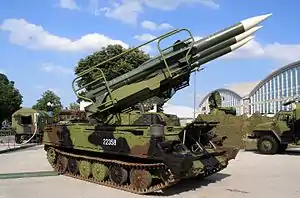
| Name | Origin | Type | In service | Notes | ||
|---|---|---|---|---|---|---|
| SAM | ||||||
| S-300PS [72] | Soviet Union | mobile SAM system | 250[1][73] | |||
| 2K12 Kub | Soviet Union | mobile SAM system | 89 [74] | M3/2D variants used | ||
| 9K37 Buk | Soviet Union | mobile SAM system | 72[1] | |||
| 9K330 Tor | Soviet Union | mobile SAM system | 100[75] | |||
| S-125 Neva/Pechora [72] | Soviet Union | mobile SAM system | 8[76] | |||
Current Structure
Ukrainian air force structure after the establishment of Air Command East on 23 January 2017:
| |||||||||||||||||||||||
Air Force Command
- Air Force Command, Vinnytsia.[77]
- 101st Separate Signals and Command Regiment, Vinnytsia
- 40th Special Signals Support Center
- 41st Intelligence Command Center
- 43rd Search and Rescue Operations Command Center
- 95th Long Distance Aviation Center
- 230th Support Base, Vinnytsia
- 7th Tactical Aviation Brigade (Bomber-Recon) "Petro Franko", Starokostiantyniv Air Base (Su-24M, Su-24MR, L-39C)
- 299th Tactical Aviation Brigade (Ground Attack) "Lt.-Gen. Vasil' Nikiforov", Kulbakino Air Base (Su-25, Su-25UB, L-39C)
- 15th Boryspil Transport Aviation Brigade "Aircraft Designer Oleg Antonov", Boryspil Airport (VIP Transport: Tu-134AK, An-30)
- 25th Transport Aviation Brigade, Melitopol Air Base (An-26, Il-76MD)
- 456th Guards Transport Aviation Brigade, Vinnytsia Airport (An-24B, An-26, Mi-8)
- 383rd Unmanned Aerial Vehicle Regiment, Khmelnitsky (Bayraktar TB2)
- 19th Separate Signals Intelligence and Intercept Regiment, Mykolaiv
- 9th Signals & Radio-Intelligence Control Point
- 182nd Joint Information and Telecommunications Node
- 204th Complex Technical Control Node
Air Command West
- Air Command West, Lviv[77]
- Command
- 193rd Airspace Control and Reporting Center, Lviv
- 76th Separate Signals and Command Regiment, Lypnyky
- 11th Security and Support Commandature, Lviv
- 114th Tactical Aviation Brigade (Fighter), Ivano-Frankivsk Air Base (MiG-29)
- 11th Anti-Aircraft Missile Regiment, Shepetivka (Buk-M1)
- 223rd Anti-Aircraft Missile Regiment, Stryi (Buk-M1)
- 540th Anti-Aircraft Missile Regiment, Kamianka-Buzka (S-300PS)
- 1st Radio-technical Brigade, Lypnyky
- 17th Separate Electronic Warfare Battalion
- 8th Aviation Commandature
- 25th Aviation Commandature
- 108th Aviation Commandature
- 204th Tactical Aviation Brigade, Lutsk Air Base (since 2018, prior to the 2014 Russian annexation of Crimea part of Task Force Crimea[78])
- supply units
Air Command Central
- Air Command Central, Vasylkiv[77]
- Command
- 192nd Airspace Control and Reporting Center, Vasylkiv
- 31st Separate Signals and Command Regiment, Kyiv
- 77th Security and Support Commandature, Vasylkiv
- 39th Tactical Aviation Brigade (Fighter),[79] Ozerne Air Base (Su-27, L-39C)
- 40th Tactical Aviation Brigade (Fighter), Vasylkiv Air Base (MiG-29, L-39C)
- 831st Tactical Aviation Brigade (Fighter), Myrhorod Air Base (Su-27, L-39C)
- 96th Anti-aircraft Missile Brigade, Danylivka (S-300PS)
- 156th Anti-aircraft Missile Regiment, Zolotonosha (Buk-M1)
- 201st Anti-aircraft Missile Regiment
- 138th Radio-technical Brigade, Vasylkiv
- 21st Aviation Commandature
- 110th Aviation Commandature
- 112th Aviation Commandature
- 215th Aviation Commandature
- supply units
Air Command South
- Air Command South, Odessa[77]
- Command
- 195th Airspace Control and Reporting Center, Odessa
- 43rd Separate Signals and Command Regiment, Odessa
- 297th Security and Support Commandature, Odessa
- 204th Sevastopol Tactical Aviation Brigade (Fighter) "Oleksandr Pokryshkin", Kulbakino Air Base (MiG-29, L-39M1)
- 160th Anti-aircraft Missile Brigade, Odessa (S-300PM)
- 208th Anti-aircraft Missile Brigade, Kherson (S-300PS)
- 201st Anti-aircraft Missile Regiment, Pervomaisk (S-300PS)
- 14th Radio-technical Brigade, Odessa
- 1194th Electronic Warfare Battalion
- 15th Aviation Commandature
- 18th Aviation Commandature
- supply units
Air Command East
- Air Command East, Dnipro
- Command
- 196th Airspace Control and Reporting Center, Dnipro
- 57th Separate Signals and Command Regiment, Dnipro
- 46th Security and Support Commandature, Dnipro
- 138th Anti-aircraft Missile Brigade, Dnipro (S-300PS)
- 3020th Anti-aircraft Missile Battalions Group
- 301st Anti-aircraft Missile Regiment, Nikopol (S-300PS)
- 164th Radio-technical Brigade, Kharkiv
- 2215th Radio-technical Battalion, Avdiivka
- 2315th Radio-technical Battalion, Rohan
- 2316th Radio-technical Battalion, Zaporizhzhia
- 2323rd Radio-technical Battalion, Mariupol
- 85th Aviation Commandature
- supply units
Training & Research
- Ivan Kozhedub National Air Force University, Kharkiv[77]
- 203rd Training Aviation Brigade, Chuhuiv Air Base & Komunar Airbase (L-39C, An-26, Mi-8T)
- NCO Personnel Military College
- 38th Joint Basic Training Center, Vasylkiv[77]
- UAV Training Center, Khmelnitsky[77]
- Mykolaiv Specialised Center for Combat Training of Aviation Personnel, Mykolayiv (Il-76MD, MiG-29, Su-25, L-39, Su-24)
- State Scientific Test and Evaluation Center of the Ukrainian Armed Forces, Chernihiv
- 41st Air Force BasicTraining Center, Danilyvka
- Koroliov Air Force Institute - Military Faculty of the National Aviation University, Kyiv
- "LDARZ" State Aviation Maintenance Plant, Lviv
- "ChARZ" Aviation Repair Plant, Chuhuiv
- "Aviakon" Aviation Repair Plant, Konotop
- "MARP" Aviation Repair Plant, Mykolaiv
Task Force Crimea
Task Force of Crimea peninsula is under the control of the Russian Armed Forces.[80][81] On April 8, 2014 an agreement had been reached between Russia and Ukraine "for the withdrawal of an undisclosed number of Ukrainian aircraft seized in Crimea".[35]
- Task Force Crimea:
- 40th Separate radio team (Liubymivka near Sevastopol)
- 204th Tactical Aviation Brigade (Belbek, near Sevastopol). Former 62nd Fighter Aviation Regiment PVO.[82] From March 1, 2014 Belbek Air Base and its 45 MiG-29s and 4 L-39s are under the control of the Russian Armed Forces.[83][84] Since 2018 the 204th Tactical Aviation Brigade is based in Lutsk Air Base.[78]
- 174th Anti-Aircraft Artillery regiment (Derhachi near Sevastopol. S-400)
- 50th Anti-Aircraft Artillery regiment (Feodosiya. S-400)[85]
- 55th Anti-Aircraft Artillery regiment (Yevpatoriya. Buk-M1)[86]
Geographic distribution

Ukrainian Air Force locations in 2018
Brigades:
Regiments/Squadrons:
List of Commanders
Pre-merger with the Air Defence Forces (1991-2004)
- 1992 – 1993 Lieutenant General Valeriy Opanasovych Vasylyev
- 1993 – 1999 Colonel General Volodymyr Mykhaylovych Antonets
- 1999 – 2002 Colonel General Viktor Ivanovych Strelnykov (detained in 2002 due to the Sknyliv air show disaster)
- 2002 – 2004 Lieutenant General Yaroslav Illich Skalko
Post-merger with the Air Defence Forces (2004–present)
- 2004 – 2007 Colonel General Anatoliy Yakovych Toropchyn
- 2007 – 2010 Colonel General Ivan Stepanovych Rusnak
- 2010 – 2012 Colonel General Serhiy Ivanovych Onyshchenko
- 2012 – 2015 Colonel General Yuriy Avramovych Baydak
- 2015 – present Colonel General Serhiy Semenovych Drozdov
See also
| Wikimedia Commons has media related to Air force of Ukraine. |
- Ukrainian Long Range Aviation
- Ukrainian Falcons aerobatic demonstration team
- Air Force ranks and insignia of Ukraine
- Antonov
Notes
- International Institute for Strategic Studies (2019). The Military Balance 2019. Routledge. p. 214.
- Ukraine leaders greet pilots on Ukrainian Air Force Day Archived 2017-08-06 at the Wayback Machine, UNIAN (6 August 2017)
- Serhiy Drozdov appointed commander of Ukrainian Air Force Archived 2016-03-04 at the Wayback Machine, Interfax-Ukraine (20 July 2015)
- "Military Balance in Europe 2011", The Military Balance, 111: 73–172, 7 March 2011, doi:10.1080/04597222.2011.559835, S2CID 219628702
- Trendafilovski, Vladimir (March 2006). "Ukrainian Reforms". Air Forces Monthly (216): 32–39.
- Air Forces Monthly, December 2007 issue, p. 64.
- "Ukraine Puts Mothballed Mig-29 Fighter Jets Back in Service". RIA Novosti. Archived from the original on 2 August 2014. Retrieved 30 October 2014.
- The conventional imbalance & debate on Russian non strategic nuclear weapons, The European leadership network, archived from the original on 6 October 2014
- "Ukraine returns combat aircraft to service". Archived from the original on 30 October 2014. Retrieved 30 October 2014.
- "Combat Aircraft, Countries Compared". Nationmaster. Archived from the original on 3 December 2014. Retrieved 29 November 2014.
- "СНБО: расторжение минских договоренностей даст повод РФ ввести "миротворцев"". LB.ua. Archived from the original on 10 November 2014. Retrieved 29 November 2014.
- "Home - MERLN - LibGuides at National Defense University". Merln.ndu.edu. 16 August 2016. Archived from the original (PDF) on 29 August 2017. Retrieved 5 January 2017.
- Holm, Michael, 161st Fighter Aviation Regiment, DK: WW2, archived from the original on 24 May 2013, retrieved 1 December 2012
- Holm, Michael, 184th Guards Heavy Bomber Aviation Regiment, DK: WW2, archived from the original on 15 June 2012, retrieved 1 November 2011
- Butowski, Piotr. "Russia's Strategic Bomber Force". Combat Aircraft. 4 (6): 552–65.
- "Long Range Aviation Museum". Tourism.Poltava.ua. Cooperative project of Fox Web Workshop and city executive committee Dept. of Culture and Tourism. Archived from the original on 2 April 2015. Retrieved 3 March 2015.
- "106th Heavy Bomber Aviation Division". Ww2.dk. Archived from the original on 25 May 2013. Retrieved 8 March 2014.
- FBIS-SOV-95-141, 21 July 1995, via BICC, 'Defence Conversion in Ukraine.'
- Дальняя авиация Украины [Ukrainian Long Range Aviation] (wiki)
|format=requires|url=(help) (article) (in Russian) - Structure, SU: 8o APVO, 1992, archived from the original on 20 January 2012
- MilBal 1992–93, 87.
- "Ukrainian air bases", Ukrwiki (article)
- "Форум газеты ПОИСК • Просмотр темы - 636 ИАП (истребительный авиационный полк) войск ПВО". Forum.gp.dn.ua. Archived from the original on 6 January 2017. Retrieved 5 January 2017.
- Jackson, Paul (March 1994), "Ukraine Unveiled", Air Forces Monthly: 21
- Шестидесятилетний юбилей отметил 5-й авиационный корпус [Diamond Jubilee noted 5th Air Corps] (in Russian), UA: Space, archived from the original on 10 May 2015, retrieved 1 November 2012
- Duncan, Andrew (April 1997), "Ukraine's forces find that change is good", Jane's Intelligence Review: 164
- "13th Guards Heavy Bomber Aviation Division". Archived from the original on 4 March 2016. Retrieved 10 November 2017.
- "Overview: the Air Forces of Ukraine". AIRheads↑FLY. Archived from the original on 11 April 2017. Retrieved 30 October 2014.
- "The Aviationist » Ukrainian Air Force". Archived from the original on 8 October 2014. Retrieved 30 October 2014.
- Ukraine will finally invest in modernising its army, PL: WAW, 1 February 2012, archived from the original on 3 May 2012, retrieved 2 October 2012
- Harro Ranter. "Aviation Safety Network > ASN Aviation Safety WikiBase > ASN Aviation Safety Database results". Archived from the original on 7 October 2014. Retrieved 30 October 2014.
- International Institute for Strategic Studies, Military Balance 2011
- Russia begins returning Ukraine naval vessels and aircraft Archived 2014-04-18 at the Wayback Machine, Jane's Defence Weekly (12 April 2014)
- "Ukraine starts restoring southern air bases". Archived from the original on 30 October 2014. Retrieved 30 October 2014.
- Beckhusen, Robert (5 June 2014). "Ukraine Resurrects Soviet-Era Super Drones". War is Boring. Archived from the original on 7 July 2014. Retrieved 5 June 2014.
- "Продовжуються роботи з відновлення військової техніки та озброєння Повітряних Сил Збройних Сил України". Ukrainian Air Force.
- "Ukrainian Air Force puts stored MiG-29s back into action". Air Heads. Archived from the original on 19 August 2014. Retrieved 5 June 2014.
- "Flight of the Phoenix, Ukrainian Style". Air Heads. Archived from the original on 21 April 2015. Retrieved 5 June 2014.
- "Армия получила новые самолеты и бронемашины. Украинская армия получила более 150 единиц техники и вооружения. На военном аэродроме под Житомиром перед армейцами выстроились два МиГа-29 и два СУ-27, БМП и БМД, транспортеры, военные джипы " | Фотогалерея | Вести". Photo.vesti-ukr.com. 6 January 2015. Archived from the original on 4 March 2016. Retrieved 5 January 2017.
- "Вооружение: Теперь нам есть чем защищать украинскую землю: Порошенко передал армии 100 единиц военной техники и 2 вертолета Ми-8. ФОТОрепортаж - Вооружение, Львовщина, Порошенко (30.12.14 17:38) « Политика Украины « Фоторепортажи | Цензор.НЕТ". Censor.net.ua. 31 December 2014. Archived from the original on 6 January 2017. Retrieved 5 January 2017.
- "Ukraine Resurrects Soviet-Era Super Drones". medium. 5 June 2014. Archived from the original on 7 July 2014. Retrieved 5 June 2014.
- "Ukrainians' Anti-Putin Strategy: Drones". VOCATIV. 30 May 2014. Archived from the original on 31 October 2014. Retrieved 19 October 2014.
- "В Ивано-Франковске ученики создали беспилотник для АТО. ФОТО". Information Resistance. 18 October 2014. Archived from the original on 19 October 2014. Retrieved 19 October 2014.
- "Students from western Ukraine build drone". UA Today. Archived from the original on 19 October 2014. Retrieved 19 October 2014.
- ""Укроборонпром" получил заказ на ремонт авиатехники". Ukrinform. Archived from the original on 26 July 2015. Retrieved 29 November 2014.
- "Введено в бойовий стрій винищувачі МіГ-29 | Міністерство оборони України". Mil.gov.ua. Archived from the original on 10 June 2016. Retrieved 5 January 2017.
- Владислав Назаркевич. Бойові літаки будуть відремонтовані + ФОТО Archived 2015-03-06 at Archive.today // «Крила України» от 29 мая 2014
- Воздушные Силы Украины получили отремонтированный зенитный ракетный комплекс Бук-М1 (фото) Archived 2016-06-04 at the Wayback Machine // УНИАН от 6 июня 2014
- Ukraine's Air Force rebuilds amid war, KyivPost, 15 March 2019, retrieved 22 February 2020
- "Ukrainian Air Force carried out the most large-scale training of fighting aircraft". Unian.net. 6 September 2007. Archived from the original on 7 February 2012. Retrieved 5 January 2017.
- "THE "SECRET WEAPON" OF UKRAINIAN MILITARY FLIGHT TRAINING". AirHeads. Archived from the original on 14 October 2014. Retrieved 29 November 2014.
- Ukraine's Diminishing Air Force Archived 2015-10-05 at the Wayback Machine, Radio Free Europe/Radio Liberty (6 October 2015)
- "World Air Forces 2020". Flightglobal Insight. 2020. Retrieved 10 March 2020.
- de Larrinaga, Nicholas (4 June 2014). "Ukraine returns combat aircraft to service". IHS Jane's Defence Weekly. IHS Jane's. Retrieved 23 July 2014.
- https://www.ukrmilitary.com/2019/12/mig29.html
- https://www.ukrmilitary.com/p/proceeds-weapons-and-equipment.html
- https://www.ukrmilitary.com/2020/07/plus-one-mig.html
- https://uprom.info/news/vpk/z-pochatku-2014-roku-sylamy-40-yi-aviabrygady-povitryanyh-syl-vdalosya-vidnovyty-pivtora-desyatka-vynyshhuvachiv-mig-29-foto/
- https://defence-ua.com/news/ldarz_peredav_ps_zsu_chergovij_modernizovanij_mig_29mu1_foto-1816.html
- https://www.ukrmilitary.com/2020/12/40-291.html
- https://www.ukrmilitary.com/2020/12/su24-54-yellow.html
- https://www.ukrmilitary.com/2019/05/su24.html
- https://www.ainonline.com/aviation-news/defense/2019-08-08/ukraine-launches-su-24-and-il-76-mro-update-program
- https://www.ukrmilitary.com/2020/11/27.html
- https://www.ukrmilitary.com/2017/02/l39m.html
- AirForces Monthly. Stamford, Lincolnshire, England: Key Publishing Ltd. September 2016. p. 37.
- "World Military Aircraft Inventory", Aerospace Source Book 2007, Aviation Week & Space Technology, January 15, 2007.
- "Ukraine - Air Force Equipment". globalsecurity.org. 2017. Retrieved 1 December 2017.
- "Нові частини ППО стають на захист України". Український мілітарний портал. 19 July 2018. Retrieved 19 February 2020.
- "Україна представила на виставці в Польщі модернізований комплекс ППО "Квадрат-2Д"". 3 September 2015. Archived from the original on 15 October 2016. Retrieved 19 February 2020.
- Rudomskii, Ruslan (27 December 2017). "Як змінилася українська армія за рік". Depo.ua. Retrieved 19 February 2020.
- Badrak, Valentyn (2 October 2019). "Нове дихання для ЗРК". День. Retrieved 19 February 2020.
- "Air Force" (in Ukrainian). Archived from the original on 19 March 2016. Retrieved 22 May 2016.
- (in Ukrainian) NOT SWORN IN: HOW THEY MET THE SEVASTOPOL TACTICAL AVIATION BRIGADE AT A NEW LOCATION, Channel 5 (09/21/2018)
- "39 окрема авіаційна ескадрилья стала бригадою". MilitaryAviation.in.UA (in Ukrainian). Archived from the original on 8 August 2018. Retrieved 30 January 2019.
- "Microsoft PowerPoint - Operation Crimea '14 update 18th March 2014.ppt [Compatibility Mode]" (PDF). Timripley.co.uk. Archived (PDF) from the original on 12 June 2016. Retrieved 5 January 2017.
- Gutterman, Steve (18 March 2014). "Putin signs Crimea treaty, will not seize other Ukraine regions". Reuters.com. Archived from the original on 9 July 2014. Retrieved 26 March 2014.
- "62nd Fighter Aviation Regiment PVO". Archived from the original on 29 April 2014. Retrieved 30 October 2014.
- "Ukrainian Commander Arrested After Russian Forces Storm Crimean Airbase, Says His Wife - ABC News". abcnews.go.com. 22 March 2014. Archived from the original on 26 March 2014. Retrieved 30 March 2014.
- "Twenty SU-27 Fighter Jets to Be Based at Crimea's Belbek Airbase". RIA Novosti. Archived from the original on 30 October 2014. Retrieved 30 October 2014.
- "Ukraine crisis: 'We won't give up without a fight'". The Guardian. Archived from the original on 14 October 2014. Retrieved 30 October 2014.
- "Russian occupants seize Base of military metrologists and aircraft repair plant in Yevpatoria". Unian.info. 19 March 2014. Archived from the original on 6 January 2017. Retrieved 5 January 2017.
References
External links
- Air Force page on the official site of Ministry of Defence:
- Photo gallery of the Ukrainian Air Force and Ukrainian Falcons in flight.
- Obsolete 1990-s pennants and patches, Linden Hill imports
- Photos of Ukrainian Air Force (in Ukrainian)
- Александров [Aleksandrov], Александр [Alexander], Вооруженные силы Украины на 1 января 2001 г [Armed Forces of Ukraine on January 1, 2001] (in Russian), RU: Soldat.
